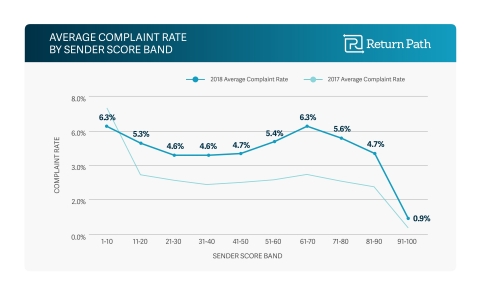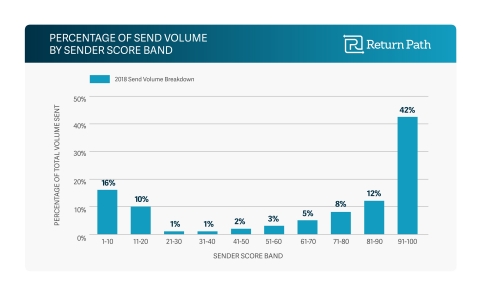New Research From Return Path Shows Sender Reputation and Email Deliverability Are Tightly Linked
Email data solutions provider Return Path released its 2019 Sender Score Benchmark. Using comprehensive data from Sender Score and Return Path’s Reputation Network, this annual report provides expert analysis and insights on how reputation impacts inbox placement for commercial email senders.
“Sender reputation offers unique insight into the source of each email, making it a key factor in those filtering decisions.”
Based on analysis of more than 4 trillion email messages, The 2019 Sender Score Benchmark reveals that highly reputable email marketers are far more likely to reach their intended audience than peers with lower reputation scores. For example, senders scoring 91-100 (the best possible reputation score) had 91 percent of their messages delivered. This figure drops to 71 percent for senders scoring 81-90, and 44 percent for senders scoring 71-80.

“Email remains the marketer’s go-to channel. But if email doesn’t reach the inbox, brands lose the opportunity to connect with customers and ultimately make a sale—so every message counts,” said Tom Sather, senior director of research at Return Path. “Since the initial Sender Score Benchmark Report in 2012, our research has consistently shown a clear link between reputation and deliverability. That’s why monitoring your reputation and maintaining it at the highest level possible is critical to email marketing success.”
Marketing Technology News: PepsiCo Foodservice Unveils New Digital Lab to Help Restaurants Thrive In The Evolving Digital Marketplace
Spam complaints are one important factor used by mailbox providers in determining which messages are unwanted and should be filtered to the junk folder. Not surprisingly, there is also a strong correlation between spam complaints and sender reputation. While year-over-year spam complaints were higher across the board, senders scoring 91-100 had an average complaint rate of just 0.9 percent. For senders scoring 81-90, this metric jumped to 4.7 percent—more than five times higher than the best senders.

“Mailbox providers face competition just like any other business, so they are constantly improving their filtering algorithms to create a better inbox experience for their users,” continued Sather. “Sender reputation offers unique insight into the source of each email, making it a key factor in those filtering decisions.”
Marketing Technology News: Motionloft named a 2019 Gartner “Cool Vendor” in Location Services and Applications
The overall quality of email has increased dramatically since Return Path’s first Sender Score Benchmark Report. In 2012, that report found that 60 percent of all email was sent by the least reputable senders—those with a Sender Score of 10 or less—while the best senders accounted for just six percent of total volume. Today, 42 percent of email comes from top senders, while email from the least reputable senders is down to just 16 percent. This shift can be attributed to the evolution of filtering technology and an increased focus on sender reputation at the mailbox provider level, all of which has made it more difficult—and far less profitable—for spammers to deliver their messages.
Marketing Technology News: Verasity Announces Integration with YouTube











